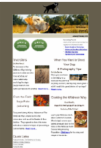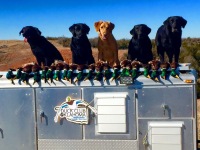“Games with a Purpose”
By Mike Stewart
Game recovery remains a primary mission for the hunting retriever. This requires not only possessing skills necessary to locate a downed bird but also the ability and determination to pick wounded birds resisting apprehension:
A Runner
A Swimmer/Diver
A Bird that launches in flight in front of the pursuing dog
In this article we will consider the latter challenge, the flight bird attempting an escape. Developing a dog’s recovery skills for birds that go “airborne” becomes an important subskill in the training process for a gundog.
Developing eye-mouth coordination begins as an element of hold-delivery conditioning. We want to develop a soft mouth as to not damage the game but one that holds a bird securely – no mouthing, dropping, or chomping. A firm, stable hold, despite the dog running, negotiating obstacles, exiting water, etc.
This is achieved through our positive hold conditioning program as seen in Sporting Dogs and Retriever Training, the Wildrose Way, page 118. It’s during the latter part of this process that the eye-mouth coordination development is perfected.
The Chase
During delivery training, movement with the bumper begins. To teach a dog to drive forward and pick a bird that has the ability to launch into flight, we first must encourage the dog to move forward to retrieve a bumper that is off the ground held at the dog’s eye level.
With the dog sitting or standing steady, extend the bumper by hand in front of the dog at eye level or a bit lower but off the ground. Give the release command to retrieve. Encourage the dog to move forward and solidly collect the bumper from hand. Once our student is confident and successful with this skill, extend the distance. Simply hold the bumper in front of the dog around eye level, give the “fetch” command, in our case, the dog’s name, then add movement by backing away holding the bumper steady at eye level. Now the dog must move quickly forward to collect the bumper. This process is introduced in the latter stage of hold conditioning so when the bumper is retrieved from hand, the dog holds it securely and returns directly and promptly, no frolicking or dropping.
Our next movement will be to engage the dog in a bit of chase. With the bumper extended, release the dog to retrieve while rotating the bumper in a circle around you requiring the dog to pursue attempting to catch the bumper.
Now elevate the bumper. Release the dog as the bumper is held higher above the dog’s head. The dog must jump to secure. Eye coordination is now becoming more important.
Finally, in this series, back away quickly as you elevate the bumper gradually upward. The dog must keep moving forward then, time the jump to make a successful pick.
The Ball Catch
Here we develop the dog’s skills to catch a tossed ball midair along with the reinforcement of steadiness by denials. With the dog standing or sitting facing the thrower, a short distance away, the tennis ball (or any reasonably sized ball that is not hard) is tossed toward the dog with the retrieve command. The ball should be somewhat above the dog’s muzzle so the dog can move forward and upward to recover. Perform this exercise with your dog on soft ground to avoid high impact on a hard surface.
Only give the dog one pick out of three tosses. Two are denials to reinforce steadiness. Gradually, with success, extend the distance and the height of the toss.
Next, add a bounce. With the dog sitting or standing, face the dog on a hard surface. The dog can be at the edge of the pavement on soft ground. Now we add a single bounce of the ball, so it bounces airborne just in front of the dog allowing the dog to catch one out of three tosses. With each denial I recommend the command “no.” With each catch, the release is the dog’s name.
Once a single catch is mastered, move on to a double bounce. Here steadiness and patience are required. If the dog moves on a double bounce too quickly, he will miss the catch. Timing and eye-mouth coordination matters.
It’s also a great exercise to place the dog on a hard surface facing a building with a slanted rooftop. The dog watches the ball as it is tossed on the roof. Soon the ball reappears high overhead and the game is on. Will the dog recover the “bird” on the first or second bounce?
Another excellent game with a purpose is the frisbee catch. It’s best to use a frisbee that is soft, not hard plastic. Begin facing the dog at a short distance. Pitch the frisbee toward the dog just above the head, slightly to the dog’s side. On command we want to dog to catch the frisbee in flight, again two out of three flights are denials. Gradually, extend the distances, time in flight and angles the dog must negotiate to recover.
The flight of a frisbee really duplicates the motion of a bird sailing by. Once the dog learns how to bolt out quickly to make a catch of the frisbee in flight, some even requiring a jump, the skill may well pay dividends in game recovery.
It’s always a good idea to get a skill right on land, then move it to the water. Practice these “catches” in shallow water to improve waterfowl recoveries.
Developing eye-to-mouth coordination with any gundog is a fun and easily perfected. By occasionally revisiting these “games with a purpose” any hunting retriever will gain proficiency in making challenging live bird recoveries. Once again, that’s the main job of a retriever. No bird left behind.




